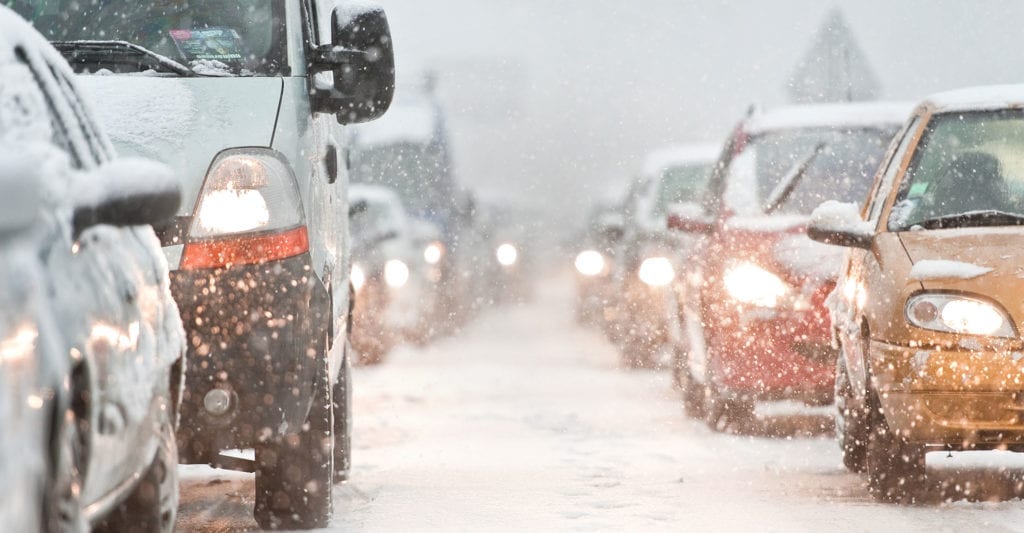BLOG – UNDER THE HOOD


December 16, 2019
7 Ways To Safer Winter Driving
Everyone hates winter driving. With hazardous conditions like ice (especially black ice), snow-covered roads and whiteouts it can be stressful and dangerous. But the truth is, we are Canadian Eh’ and winter driving is unavoidable. Unless you call in sick every day and have your groceries delivered to your door, you can’t get around having to drive in the snow.
Improve your winter driving significantly and reduce your risk of an accident with these seven tips for safer winter driving.
- Have proper winter tires
Make sure you have the proper snow tires for your vehicle. All seasons are okay for light winter driving like during the early spring or before the big dumps of snow, but winter tires are designed to gather less snow in the treads, give better traction on the ice and handle the frigid cold temperatures. For added traction and safer winter driving, you could have your winter tires studded. Before studding your tires, be sure to check the regulations for your region. You may even be able to score a discount on your insurance if your vehicle is equipped with winter tires.
2. Leave earlier
Your everyday commute might be only 15 minutes during the summer months but after a dump of snow or freezing rain, that time might double. Give yourself plenty of extra time to get to your destination. Take into consideration the road conditions, being stuck behind a snowplow or even the possibility of being held up by an accident. By giving yourself extra time, you can drive an appropriate speed for the road conditions and make safer winter driving a top priority.
3. Increase your following distance
Don’t be the person who drives so close to the car in front of them that you can see what they are listening to on the radio, especially in the winter. We don’t suggest following that close on a good day, but during the winter months, you really need to increase your following distance to allow yourself plenty of extra space for sudden braking and possible sliding. Even if the roads don’t appear icy, a thin layer of frost is enough to send you sliding into someone’s back bumper.
4. Eliminate all distractions
You’ve heard it said before, “distracted driving leads to more accidents”, but it’s only because it’s true. Your cell phone (texting or calling), messing with the radio, eating or digging around for something in your bag…all of these things can lead to an accident and are oftentimes fatal. Send a text before you leave and reply only when you’ve reached your destination. Pullover to make a call or set up your Bluetooth before leaving, keep your front seats empty and free of clutter (toss your purse into the backseat if it’s a distraction) and focus on nothing but the road.
5. Keep up with basic vehicle maintenance
Never leave home with empty winter windshield washer fluid, keep your headlights clean and replace dull/burnt out bulbs when needed. Dropping temperatures can cause fluctuations in tire pressure (sometimes a drastic change can occur) and not all vehicles are equipped with a TPMS (tire-pressure monitor sensor). Be sure to check your tire pressure often and fill any tire that is too low. If you notice a tire getting low too often there is a chance it needs to be replaced.
6. Don’t ignore minor windshield damage
It might seem small and insignificant, but even a small chip can often turn into a fully cracked windshield during the winter months, especially when temperatures change drastically. Damage to your windshield is dangerous for two main reasons: it decreases visibility and it weakens the windshield providing less protection in the event of an accident. We can even help you determine whether or not your windshield needs replacing.
7. Be prepared for anything
Although it’s not about your physical driving skills, being prepared for anything can make all the difference in the event of a breakdown or accident. Our winters present some challenges like icy roads, lots of snow and frigid temperatures. There is nothing worse than getting stranded on the side of the road in the middle of winter with no gas and no emergency kit. To keep yourself safe in a situation like this, never leave home without at least half a tank of fuel and a proper emergency kit. Keep extra blankets, a lighter, a small shovel, a tow rope, a first-aid kit and some non-perishable food in your vehicle. A proper emergency kit is just like your car insurance, you may never need to use it but it can save you if something happens.
There is no way to completely avoid winter driving, icy roads and snowstorms (unless you move south of course.) But if everyone on the road just put a little bit more care into safer winter driving, we could all feel a little more at ease when we head out onto the snow-covered highways.
Even if we all gave safer winter driving our best effort, accidents are still going to happen, that’s why they are called accidents. Unforeseen things like black ice and wildlife can cause accidents that no amount of careful driving can prevent. So in the unfortunate event that you DO get into an accident, know where to turn. CSN JD Collision, located in Alberta’s Lakeland, is a shop you can trust. With over 40 years of experience in the auto body industry and top of the line repair technology, leading-edge customer service and affordable pricing, we can make the repair process as smooth and stress-free as possible.
If you were recently in an accident and your vehicle needs repairs, contact us today and we will help you through the entire process. From start to finish, we’ve got your back.